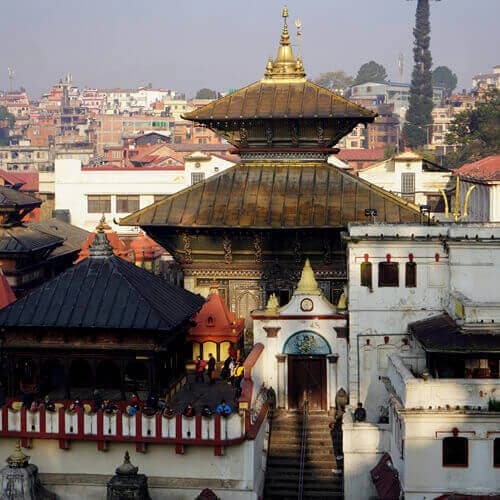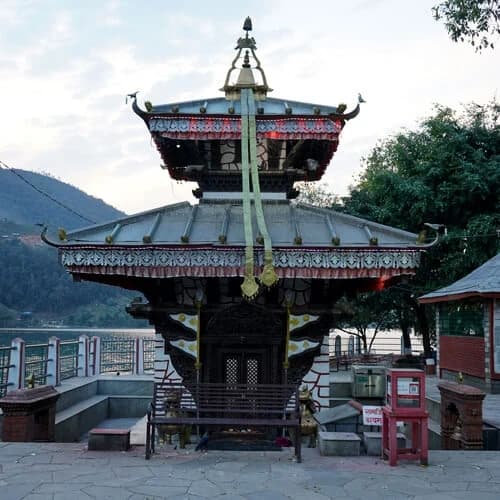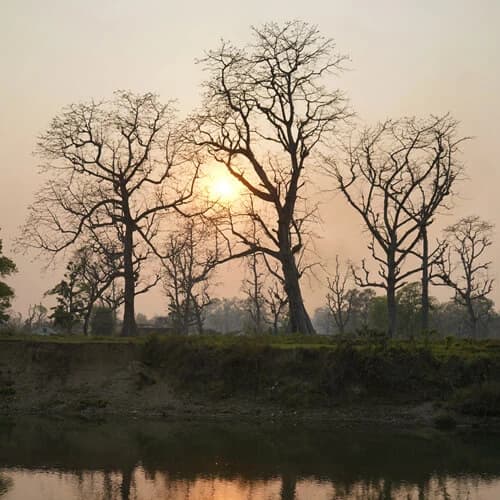Major attractions of Everest Base Camp with Island Peak Expedition
A daring flight to Lukla
Lukla, the starting point of the Island Peak Climb, is only 30 minutes away from Kathmandu by flight. It takes a lot of grit to stay on the short flight from Kathmandu to Lukla. It will be a breathtakingly gorgeous and thrilling flight. This spectacular flight is one of the best experiences of the Island Peak Climb.
What is it about this flight that makes it so thrilling? It is, in fact, Lukla Airport's landing strip. It features one of the world's shortest runways at 525 meters (1,729 feet) and one of the world's highest airports at 2,845 m (9,334 feet). When you consider the runway's steepness, which dangles off the side of a mountain, it's bound to give you an adrenaline rush!
Wilderness in the UNESCO World Heritage Site
The trail to EBC and Island Peak travels through Sagarmatha National Park, which offers a diverse range of climate zones and vegetation. From Monjo onwards, you hike through Sagarmatha National Park, which is home to hundreds of species of flora and fauna. This national park is also a UNESCO World Natural Heritage Site. The route includes several ascents and descents, as well as crossing several streams and dense woodlands. Lhotse, Cho Oyu, Pumori, Ama Dablam, Thamserku, Kwangde, Kangtaiga, and Gyachyung Kang can all be seen during your journey through Sagarmatha National Park.
Namche Bazaar, the mystical Himalayan village
The Island Peak Climbing route passes through Namche Bazaar, which is a significant stopover. If you wish to discover Nepal's Himalayan region and mountains, this is the place to be in! Even before you reach Namche Bazaar, you can catch the first glimpse of Everest! At 3,500 meters above sea level, Namche Bazaar serves as the starting point for treks to Everest and other Himalayan peaks. It's a lively market town that sells everything from trekking and climbing gear to Tibetan souvenirs. Namche is well-known for its yak cheese and butter.
The Everest region's gateway, Namche, also serves as a memorial to previous climbing expeditions and provides information on Sherpa culture and way of life. Nestled on the side of an arch-shaped mountain with panoramic views of the Himalayan peaks from all locations in the valley, Namche was formerly an important trading center in the Khumbu region. To adapt to increasing altitude, trekkers frequently stay here for several days. It goes without saying that your stay in Namche will be memorable.
Tengboche Monastery and its spiritual significance
The Tengboche Monastery is the main attraction for trekkers, mountaineers, and everyone else along the Island Peak trekking route. This historic monastery, which is also a significant religious holy site in Khumbu, offers spectacular views of Mt. Ama Dablam and the surrounding Himalayas. Guru Rinpoche blesses all the pilgrims and guests who enter this sacred location.
The Tengboche monastery was built in 1961 but was destroyed by the 1934 earthquake. In the same year, the monastery was renovated. The monastery, however, was completely destroyed by fire in 1989 and had to be rebuilt. Despite these tragedies, the Tengboche Monastery remains the oldest and largest in the Khumbu region.
A hike to Everest Base Camp
Everest Base Camp is located at the foot of the Khumbu Glacier, surrounded by some of the world's most famous peaks. The base camp is a must-see for climbers from all over the world. Thousands of trekkers visit the base camp and other Nepalese circuits each year, even though they don't attempt to summit the peaks. In and of itself, reaching Everest Base Camp is an outstanding achievement as it is at the foothill of the world's highest mountain (8,848 m). Everest Base Camp offers stunning views of the Himalayan Mountains and glaciers, though you can't see the summit of Everest from here.
Kala Patthar with clear views of the Everest
Kala Patthar is a fantastic vantage point for seeing Mount Everest's face, which is not visible from the base camp. Kala Patthar, a mountain crest that offers incredible views of the surrounding mountains, is a short hike from Gorakshep. You can see one of the most beautiful views of Everest and Ama Dablam from Kala Patthar. Similarly, as the light rays reach the summit, the sunrise vista of the Everest peak is stunning. Thus, Kala Patthar is considered the best viewing location in the Everest region.
Witnessing the Sherpa's unparalleled culture
Sherpas are among the uniquely cultural Nepali Indigenous groups. Sherpas have earned respect for delivering clients to the summit of Mount Everest, one of the world's most hazardous destinations. The Everest region was extremely remote until adventure trekking was introduced.
Along with being brave souls in the Himalayas, Sherpas are also true to their culture. They follow traditional Tibetan Buddhism that has been passed down to them for centuries. Get to know the authentic Sherpa culture en route to Island Peak.
Everest Base Camp with Island Peak Weather and Best Time
The 16 Days Ebc Trek with Island Peak Climbing is a famous expedition in Nepal, which most mountaineers climb to prepare for Mount Everest. The gorgeous views from the summit of Island Peak are equal to those of any summit in the surrounding region. The peak appears to be an island in a sea of ice, which is where it got its name. During the peak season, the route to the peak is filled with adventurers and mountaineers. The expedition is an ideal option for seasoned trekkers who are well-versed in the steep and rocky terrains of the Himalayas. Regardless of your expertise, you must choose the best time with the suitable weather conditions to enjoy a remarkable trekking experience. Nepal has five seasons: summer, monsoon, winter, spring, and autumn. Spring and autumn are the best times to commence the Everest Base Camp with Island Peak due to the favorable weather conditions.
Autumn: The autumn season includes the months of September, October, November, and December. During this time of the year, the temperatures range between 14 and 10 degrees Celsius in the daytime and fall to -5 and 10 degrees Celsius at night. The weather is ideal, with little rain and snowfall. Further, the sky will be clear, enabling you to enjoy the best views of the surrounding mountains and landscapes.
Spring: Spring lasts from February, March, April, and May in Nepal, and the weather conditions during this time are stable with moderate climate conditions. This makes it the perfect time of the year for travelers to trek in several Himalayan regions spread across Nepal. You will be able to come across several plants and flowers in full bloom in the spring. The trail you will hike on will also be dry and non-slippery, enabling you to stroll along the landscape comfortably. Besides, because it is peak season, you will come across several trekkers along the trail, and the teahouses will buzz with them.
EBC Trek With Island Peak in Monsoon and Winter (not recommended)
The ascent to the Island Peak is possible at any time of the year. However, the trip to the Island Peak is especially more strenuous during monsoon and winter. It is difficult during monsoons because of the erratic weather pattern, continuous rainfall, and muddy trails. However, it is not impossible. Here at Outfitter Nepal, we have had guests who have climbed the Island peak even during the harsh monsoons of June and July. Although, you might as well have to carry extra gear for your safety on the slippery slope.
Similarly, it will be exceedingly cold during the winter. You'll need to bring extra clothing with you to keep yourself warm. On top of that, the snow on the trail is at its heaviest in the winter. With many inches of snow piling up and occasionally obstructing the trail, it will become much more difficult to navigate the trail. The weather is also particularly nasty and difficult.
Thus, with our years of experience in the trekking and climbing sector, we believe, spring and autumn are the best times for your Island Peak Climbing adventure!
Everest Base Camp With Island Peak Grade
Island Peak climbing grade is PD+ (Per Difficulty) based on the French and Swiss Alpine Climb Classification System. It is used worldwide on this alpine style of day climb which grades Island Peak as a straightforward ascent to the summit with some technical effort required where all climbers must be properly equipped.
Everest Base Camp With Island Peak Difficulty
The Island peak climb is rated to be very strenuous. On a daily basis, the trek takes about 4 to 7 hours and includes hills and difficult terrain. Another hurdle is passing across glaciers, rivers, rocky terrain, and mountain passes. On the summit day, you'll have to climb for 12 to 13 hours straight and cover a distance of roughly 10 kilometers. The weight of your heavy winter apparel, as well as the 7 to 10kg of your bag, adds to the difficulty. These are some of the reasons why summiting Island Peak requires great physical fitness.
It is especially suitable for those trekking enthusiasts who want to start their mountain climbing experience. It will be reasonably easy for experienced hikers with a high degree of fitness. Even if you have no prior climbing expertise, you can climb the peak if you’re confident when trekking at high altitudes. Basic mountaineering abilities are beneficial but not necessary because the team will provide pre-climb instructions. If you have a pre-existing heart or lung condition, or if you have knee weakness, you should first consult your doctor to see if you can attempt the climb.
Altitude Sickness during the Everest Base Camp With Island Peak
The Nepalese Himalayan is exceptionally high in elevation. With eight of the world's highest peaks exceeding 8000 meters, including Everest, the height for climbing and expeditions may be too high for novices and intermediate climbers. If taken casually, the abrupt shift in altitude could be problematic.
The amount of oxygen available reduces as the altitude rises. Furthermore, the quick shift in temperature may cause altitude sickness in some people. Vomiting, fainting, nausea, and headache are some of the early symptoms that trekkers may experience. It can happen to anyone, regardless of their degree of fitness. Thus, it is preferable to adapt and travel at a relaxed pace. If you experience any of these symptoms, it’s best to let the guide know.
Safety during the Ebc Trek With Island Peak
On Island Peak, you are not as exposed as you are on Mount Everest and similar peaks. The few Island peak expeditions that have been recorded, on the other hand, were caused by altitude sickness. You can also learn how to avoid altitude sickness, the most common source of problems in the Himalayas.
At Outfitter Nepal, we place the highest priority on safety. Thus, when it comes to keeping the cost of our climbs and treks affordable, this is one area where we simply do not cut corners. Trekking businesses and guides are chosen for their technical expertise, demonstrated safety performance, flawless judgment, courteous demeanor, and ability to deliver valuable and professional information. They're also quite professional and well-versed in first aid and personal safety equipment. All guided treks and excursions to Everest Base Camp and Island Peak come equipped with first aid kits.
Training for Everest Base Camp With Island Peak
It will be difficult to prepare your legs for greater elevations if you do not reside in the Himalayas. It doesn't get much higher than Nepal, after all. This is why we must be upfront: Unless you have previously trekked at a higher altitude, becoming fully prepared for your expedition will be challenging. If that seems frightening, rest assured that you do not need to be 100 percent prepared.
Island Peak is a climbing and trekking expedition. It's recommended that you take it easy. When it comes to preventing altitude sickness while hiking in Nepal, the rule of thumb is to take it easy. It makes no difference how fit you are; once you're out on the trails, you must go at your own pace. Of course, the more fit you are, the more you will be able to enjoy your vacation. So, the best training for Island Peak Climbing is to get in shape!
Rehearsing is a good way to get the swing of what you're doing. Actual climbing is the finest climbing practice. But multiple days of hiking also work well. We assume you love hiking because you are up for a multi-day trekking adventure. If you are fortunate enough to be surrounded by hills or even mountains, now is the time to pack your bags and explore them. When? If you're new to this, we recommend starting your practice trek 6 months in advance. Carry a 5 - 10 kg pack and schedule a three-hour hike into your week.
You'll have an excellent opportunity to enhance your power once you've gotten the hang of it, which should take about a month. If this style of life is different from yours, you will get the benefits of this moderate exercise in no time.
Food and Accommodation during the Island Peak Ascent
Climbing in high altitudes requires a lot of energy, carbs, and proteins! Local cuisine and delicacies are significantly more hygienic, thus we encourage people to eat local. Frozen snacks and meat items that take days to reach the trails are not the best option.
We recommend Dal Bhat, a Nepalese dish that supplies your body with the necessary carbohydrates and protein. The lentils, beans, and pulses soup contain a lot of protein. Another popular cuisine is syakpa, often known as Sherpa stew. Seasonal veggies will be served in the tea houses, supplying critical nutrients to your body. High-fiber grains including buckwheat, millet, and barley are also nutritionally dense. Noodles, spaghetti, macaroni, pizza, lasagna, a variety of curry meals, and fried rice are just a few of the cuisines available.
We can also help you discover a high-end hotel and teahouse that fits your budget. During the Island Peak Ascent, luxury and premium hotels and lodges, as well as budget hotels and lodges, are available wherever possible. You’ll mostly be staying in a 3-star hotel in Kathmandu while spending nights at decent mountain lodges and teahouses during the trek and tented camps at Island Peak Base Camp.
In the mountains, comfortable mattresses with cushions, electric blankets, hot and cold showers, free Wi-Fi, and other options are provided in the rooms. The rooms are often tiny yet cozy, and two guests frequently share them. The room includes a mattress, blanket, and pillow, among other things. We can provide separate rooms for you if you're traveling alone.
Sherpas, Guides, and Porters for EBC Trek with Island Peak
You need a Sherpa mountain guide to climb mountains in Nepal. Your ascent will be supported by an experienced Sherpa guide who will assist you with the climb once you reach the base camp. They will give you directions, fix the ropes, guide the way, and help you as needed from the base camp to the summit and back. Additionally, they will consider the weather before deciding when to begin each ascent. We provide 1 climbing guide for 2-3 climbers based on the climber’s prior experience.
The Island Peak Climbing involves several days of hiking in the Everest region both before and after the summit. There is no need for a guide when trekking in this area. A hiking guide, however, significantly improves the success of your journey. An experienced trekking guide will be provided by Outfitter Nepal for each excursion. Your group will therefore have a trekking guide who will assist you in navigating the terrain, reserving lodging along the hiking track, interacting with locals, and handling emergencies.
Your climbing equipment is heavy and will need to be transported to base camp by a porter. You can hike worry-free with our Island Peak Climbing package, which includes one potter for every 2 climbers. A potter can only carry 20-22 kg and will only help you get to base camp. Then, you'll have to carry your own climbing equipment or seek your Sherpa's assistance.
Permits for Everest Base Camp With Island Peak
- The following permits are required for trekking to Everest Base Camp and climbing Island Peak:
- Khumbu Pasang Lhamu Rural Municipality Entry Permit - US$ 20
- Sagarmatha National Park Entry Permit - US$ 30
Island Peak Climbing Permit - The Nepal Mountaineering Association (NMA) classifies Island Peak as a Group B climbing peak that requires both a climbing and trekking permit. The cost of a climbing permit varies from US$ 70 to US$ 250 per person depending on the season and is provided by the NMA, whereas a Local Area Permit for trekking is US$ 20





